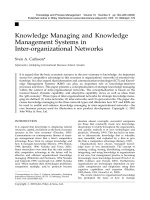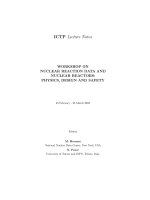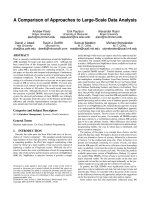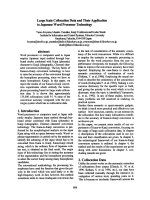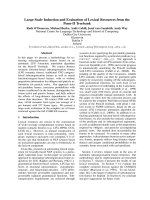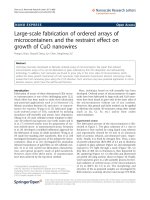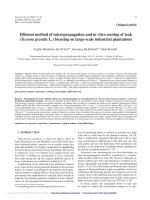Transactions on large scale data and knowledge centered systems XXVII
Bạn đang xem bản rút gọn của tài liệu. Xem và tải ngay bản đầy đủ của tài liệu tại đây (22.37 MB, 220 trang )
Journal Subline
LNCS 9860
Amin Anjomshoaa • Patrick C.K. Hung
Dominik Kalisch • Stanislav Sobolevsky
Guest Editors
Transactions on
Large-Scale
Data- and KnowledgeCentered Systems XXVII
Abdelkader Hameurlain • Josef Küng • Roland Wagner
Editors-in-Chief
Special Issue on Big Data for Complex Urban
Systems
123
Lecture Notes in Computer Science
Commenced Publication in 1973
Founding and Former Series Editors:
Gerhard Goos, Juris Hartmanis, and Jan van Leeuwen
Editorial Board
David Hutchison
Lancaster University, Lancaster, UK
Takeo Kanade
Carnegie Mellon University, Pittsburgh, PA, USA
Josef Kittler
University of Surrey, Guildford, UK
Jon M. Kleinberg
Cornell University, Ithaca, NY, USA
Friedemann Mattern
ETH Zurich, Zurich, Switzerland
John C. Mitchell
Stanford University, Stanford, CA, USA
Moni Naor
Weizmann Institute of Science, Rehovot, Israel
C. Pandu Rangan
Indian Institute of Technology, Madras, India
Bernhard Steffen
TU Dortmund University, Dortmund, Germany
Demetri Terzopoulos
University of California, Los Angeles, CA, USA
Doug Tygar
University of California, Berkeley, CA, USA
Gerhard Weikum
Max Planck Institute for Informatics, Saarbrücken, Germany
9860
More information about this series at />
Abdelkader Hameurlain Josef Küng
Roland Wagner Amin Anjomshoaa
Patrick C.K. Hung Dominik Kalisch
Stanislav Sobolevsky (Eds.)
•
•
•
Transactions on
Large-Scale
Data- and KnowledgeCentered Systems XXVII
Special Issue on Big Data for Complex Urban
Systems
123
Editors-in-Chief
Abdelkader Hameurlain
IRIT
Paul Sabatier University
Toulouse
France
Roland Wagner
FAW
University of Linz
Linz
Austria
Josef Küng
FAW
University of Linz
Linz
Austria
Guest Editors
Amin Anjomshoaa
MIT Senseable City Lab
Cambridge, MA
USA
Patrick C.K. Hung
Faculty of Business and Information
Technology
University of Ontario Institute
of Technology (UOIT)
Oshawa, ON
Canada
Dominik Kalisch
Trinity University
Plainview, TX
USA
Stanislav Sobolevsky
New York University
Brooklyn, NY
USA
ISSN 0302-9743
ISSN 1611-3349 (electronic)
Lecture Notes in Computer Science
ISBN 978-3-662-53415-1
ISBN 978-3-662-53416-8 (eBook)
DOI 10.1007/978-3-662-53416-8
Library of Congress Control Number: 2016950413
© Springer-Verlag GmbH Germany 2016
This work is subject to copyright. All rights are reserved by the Publisher, whether the whole or part of the
material is concerned, specifically the rights of translation, reprinting, reuse of illustrations, recitation,
broadcasting, reproduction on microfilms or in any other physical way, and transmission or information
storage and retrieval, electronic adaptation, computer software, or by similar or dissimilar methodology now
known or hereafter developed.
The use of general descriptive names, registered names, trademarks, service marks, etc. in this publication
does not imply, even in the absence of a specific statement, that such names are exempt from the relevant
protective laws and regulations and therefore free for general use.
The publisher, the authors and the editors are safe to assume that the advice and information in this book are
believed to be true and accurate at the date of publication. Neither the publisher nor the authors or the editors
give a warranty, express or implied, with respect to the material contained herein or for any errors or
omissions that may have been made.
Printed on acid-free paper
This Springer imprint is published by Springer Nature
The registered company is Springer-Verlag GmbH Germany
The registered company address is: Heidelberger Platz 3, 14197 Berlin, Germany
Editorial Preface
Living in cities is becoming increasingly attractive for many people around the world.
According to the United Nations, more than 3.8 billion or 53.6 % of the world’s
population were living in urban agglomerations in 2014. Especially from an ecological
point of view, cities are a central issue for the future. Cities consume enormous
amounts of energy, raw materials, and space, additionally producing tons of waste and
hazardous materials, while many places suffer from congestion, traffic jams, crime, etc.
Today’s cities are using systems and infrastructure that are partly based on outdated
technologies, making them unsustainable, inflexible, inefficient, and difficult to change.
In addition, the increasing pace of urbanization and transformation of the cities challenges traditional approaches for urban system forecasting, policy, and decisionmaking even further. In order to solve these challenges, we have to understand cities as
hyper-complex interdependent systems that, with their interconnected layers and subsystems, cannot be efficiently understood separately from one another, but form a
complex interdependent system of infrastructural, economic, and social components
that require a holistic system model.
On the other hand, modern challenges in complex urban system studies come
together with new unprecedented opportunities, such as digital sensing. The technological revolution resulted in the broad penetration of digital technologies in the
everyday life of people and cities, creating big data records of human behavior. Also,
recent advances in network science allow for deeper interactions between people,
companies, and urban infrastructure from the new complex network perspective.
There is already a modern trend in urban planning to use the data that are available
to improve quality of life, reduce costs, and objectify planning decisions. This is
especially true for many cities — like Chicago or New York — which have begun to
roll out urban sensor data for managing the city. Data, analytics, and technology are
therefore the keys to making these data not only accessible, but to gain meaningful
insights into urban systems to understand the city, allow evidence-based decisions, and
create sustainable solutions and innovations improving the quality of urban life.
However, the high complexity of modern urban systems creates a challenge for the
data and analytic methods used to study them, calling for newer approaches that are
more unified, robust, and efficient.
The goal of this proposed special issue is to delineate important research milestones
and challenges of big data-driven studies of the complex urban systems, discussing
applicable data sources, methodology, and their current limitations.
This special issue contains 12 papers that contribute in-depth research of the subject.
The results of these papers were presented at the symposium Big Data and Technology
for Complex Urban Systems held during the 49th Hawaii International Conference in
System Sciences on January 5, 2016.
The first contribution is “Brazilians Divided: Political Protests as Told by Twitter”
by Souza Carvalho et al. This paper presents two learning algorithms to classify tweets
VI
Editorial Preface
in Twitter for an exploratory analysis so as to acquire insights of the inner divisions and
their dynamics in the pro- and anti-government protests in the Brazilian presidential
election campaign in 2014. The results show that there are slightly different behaviors
from both sides, in which the pro-government users criticized the opposing arguments
prior to the event, whereas the group against the government generated attacks during
different times, as a response to supporters of the government.
Next, the second contribution “Sake Selection Support Application for Countryside
Tourism” by Iijamai et al. discusses a study to investigate a way of attracting foreign
tourists to participate in “Sake Brewery Tours” for the Tokyo Olympic Paralympic
Games in 2020. This paper demonstrates a related application to engage foreign tourists
who are not originally interested in sake.
The following contribution by Kalisch et al. is “A Holistic Approach to Understand
Urban Complexity” and gives an introduction to the interdependent complexity of
urban systems, addressing necessity for research in this field. Based on an
industry-funded qualitative research project, the paper outlines a holistic approach to
understanding urban complexity. The goal of this project was to understand the city in
a holistic way, applying the approach of system engineering to the field of urban
development, as well as to identify the key factors needed to redesign existing and
newly emerging cities in a more sustainable way. The authors describe the approach
and share a summary of a case study analysis of New York City.
The contribution entitled “Real-Time Data Collection and Processing of Utility
Customer’s Power Usage for Improved Demand Response Control,” by Shawyun
Sariri et al., investigates potential demand response solutions that provide cost-effective
alternatives to high priced spinning reserves and energy storage. The context of the
study focuses on the implementation of a pilot program, which aids in the understanding of large data collection in dense urban environments. Understanding the
power consumption behavior of a consumer is key in implementing efficient demand
response programs. Factors affecting large data collection such as infrastructure, data
storage, and security are also explored.
The paper “Development of a Measurement Scale for User Satisfaction with E-Tax
Systems in Australia” by A. Alghamdi and M. Rahim explores satisfaction of
e-government systems in general and e-tax systems in particular. The paper develops a
satisfaction construct of such e-tax systems and evaluates the approach in two steps.
The conceptual model construct is being evaluated by an expert panel, and there is also
a pilot evaluation of the survey instrument developed based on that model. The authors
present the first overview of factors that are important for user satisfaction with e-tax
systems.
The next two papers focus on the creation of open government data (OGD) resources. The first OGD contribution, entitled “Data-Driven Governments: Creating
Value Through Open Government Data” by Judie Attard et al., explores existing
processes of value creation on government data. The paper identifies the dimensions
that impact, or are impacted by, value creation and distinguishes between the different
value-creating roles and participating stakeholders. The authors propose the use of
linked data as an approach to enhance the value creation process and provide a value
creation assessment framework to analyze the resulting impact. They also implement
the assessment framework to evaluate two government data portals.
Editorial Preface
VII
The second OGD contribution, entitled “Collaborative Construction of an Open
Official Gazette” by Gisele S. Craveiro et al., aims at describing the strategies adopted
for preparing the implementation of an open official gazette at the municipal level. The
proposed approach is a combination of bibliographical review, documentary research,
and direct observation. The paper also describes the strategies and activities put into
effect by a public body and an academic group in preparing the implementation of the
open official gazette and analyzes the outcomes of these strategies and activities by
examining the tool implemented, the traffic, and the reported uses of the open Gazette.
The next contribution, entitled “A Solution to Visualize Open Urban Data for
Illegally Parked Bicycles” by Shusaku Egami et al., presents a crowd-powered open
data solution for the illegal parking of bicycles in urban areas. This study proposes an
ecosystem that generates open urban data in link data format by socially collecting the
data, complementing the missing data, and then visualizing the data to facilitate and
raise social awareness about the problem.
The contribution, entitled “An Intelligent Hot-Desking Model Based on Occupancy
Sensor Data and Its Potential for Social Impact” by Konstantinos Maraslis et al.,
proposes a model that utilizes occupancy sensor data in a commercial hot-desking
environments. The authors show that sensor data can be used to facilitate office
resource management with results that outweigh the costs of occupancy detection. The
paper shows that the desk utilization can be optimized based on quality occupancy data
and also demonstrates the effectiveness of the model by comparing it with a theoretically ideal, but impractical real-life model.
The following contribution, “Characterization of Behavioral Patterns Exploiting
Description of Geographical Areas” by Zolzaya Dashdorj et al., investigates relationships existing between human behavior measured through mobile phone data records
on one hand, and location context, measured through the presence of points of interest
of different categories, on the other. Advanced machine-learning techniques are used to
predict a timeline type of communication activity in a given location based on the
knowledge of its context, and it is demonstrated that the classification based on
point-of-interest data has additional predictive power compared with the official data,
such as the land use classification.
The contribution “Analysis of Customers’ Spatial Distribution Through Transaction
Datasets” by Yuji Yoshimura et al. studies people’s consumption behavior and
specifically customer mobility between retail stores, using a large-scale anonymized
dataset of bank card transactions in Spain. Various spatial patterns of customer
behavior are discovered, including spatial distributions of customer activity with
respect to the distance from the considered store.
The last contribution, “Case Studies for Data-Driven Emergency Management/
Planning in Complex Urban Systems” by Kun Xie et al., considers five related case
studies within the New York/New Jersey metropolitan area in order to present a
comprehensive overview on how to use big urban data (including traffic operations,
incidents, geographical and socio economic characteristics, and evacuee behavior) to
obtain innovative solutions for emergency management and planning, in the context of
VIII
Editorial Preface
complex urban systems. Useful insights are obtained from the data for essential tasks of
emergency management and planning such as evacuation demand estimation, determination of evacuation zones, evacuation planning, and resilience assessment.
July 2016
Amin Anjomshoaa
Patrick C.K. Hung
Dominik Kalisch
Stanislav Sobolevsky
Organization
Editorial Board
Reza Akbarinia
Bernd Amann
Dagmar Auer
Stéphane Bressan
Francesco Buccafurri
Qiming Chen
Mirel Cosulschi
Dirk Draheim
Johann Eder
Georg Gottlob
Anastasios Gounaris
Theo Härder
Andreas Herzig
Dieter Kranzlmüller
Philippe Lamarre
Lenka Lhotská
Vladimir Marik
Franck Morvan
Kjetil Nørvåg
Gultekin Ozsoyoglu
Themis Palpanas
Torben Bach Pedersen
Günther Pernul
Sherif Sakr
Klaus-Dieter Schewe
A Min Tjoa
Chao Wang
INRIA, France
LIP6 – UPMC, France
FAW, Austria
National University of Singapore, Singapore
Università Mediterranea di Reggio Calabria, Italy
HP-Lab, USA
University of Craiova, Romania
University of Innsbruck, Austria
Alpen Adria University Klagenfurt, Austria
Oxford University, UK
Aristotle University of Thessaloniki, Greece
Technical University of Kaiserslautern, Germany
IRIT, Paul Sabatier University, France
Ludwig-Maximilians-Universität München, Germany
INSA Lyon, France
Technical University of Prague, Czech Republic
Technical University of Prague, Czech Republic
Paul Sabatier University, IRIT, France
Norwegian University of Science and Technology,
Norway
Case Western Reserve University, USA
Paris Descartes University, France
Aalborg University, Denmark
University of Regensburg, Germany
University of New South Wales, Australia
University of Linz, Austria
Vienna University of Technology, Austria
Oak Ridge National Laboratory, USA
External Reviewers
Mohammed Al-Kateb
Teradata, USA
Contents
Brazilians Divided: Political Protests as Told by Twitter . . . . . . . . . . . . . . .
Cássia de Souza Carvalho, Fabrício Olivetti de França,
Denise Hideko Goya, and Claudio Luis de Camargo Penteado
1
Sake Selection Support Application for Countryside Tourism . . . . . . . . . . . .
Teruyuki Iijima, Takahiro Kawamura, Yuichi Sei, Yasuyuki Tahara,
and Akihiko Ohsuga
19
A Holistic Approach to Understand Urban Complexity: A Case Study
Analysis of New York City . . . . . . . . . . . . . . . . . . . . . . . . . . . . . . . . . . .
Dominik Kalisch, Steffen Braun, and Alanus von Radecki
Real-Time Data Collection and Processing of Utility Customer’s Power
Usage for Improved Demand Response Control . . . . . . . . . . . . . . . . . . . . .
Shawyun Sariri, Volker Schwarzer, Dominik P.H. Kalisch,
Michael Angelo, and Reza Ghorbani
31
48
Development of a Measurement Scale for User Satisfaction with E-tax
Systems in Australia . . . . . . . . . . . . . . . . . . . . . . . . . . . . . . . . . . . . . . . .
Abdullah Alghamdi and Mahbubur Rahim
64
Data Driven Governments: Creating Value Through Open
Government Data . . . . . . . . . . . . . . . . . . . . . . . . . . . . . . . . . . . . . . . . . .
Judie Attard, Fabrizio Orlandi, and Sören Auer
84
Collaborative Construction of an Open Official Gazette . . . . . . . . . . . . . . . .
Gisele S. Craveiro, Jose P. Alcazar, and Andres M.R. Martano
111
A Solution to Visualize Open Urban Data for Illegally Parked Bicycles . . . . .
Shusaku Egami, Takahiro Kawamura, Yuichi Sei, Yasuyuki Tahara,
and Akihiko Ohsuga
129
An Intelligent Hot-Desking Model Based on Occupancy Sensor Data
and Its Potential for Social Impact. . . . . . . . . . . . . . . . . . . . . . . . . . . . . . .
Konstantinos Maraslis, Peter Cooper, Theo Tryfonas,
and George Oikonomou
Characterization of Behavioral Patterns Exploiting Description
of Geographical Areas . . . . . . . . . . . . . . . . . . . . . . . . . . . . . . . . . . . . . . .
Zolzaya Dashdorj and Stanislav Sobolevsky
142
159
XII
Contents
Analysis of Customers’ Spatial Distribution Through Transaction Datasets . . .
Yuji Yoshimura, Alexander Amini, Stanislav Sobolevsky, Josep Blat,
and Carlo Ratti
177
Case Studies for Data-Oriented Emergency Management/Planning
in Complex Urban Systems . . . . . . . . . . . . . . . . . . . . . . . . . . . . . . . . . . .
Kun Xie, Kaan Ozbay, Yuan Zhu, and Hong Yang
190
Author Index . . . . . . . . . . . . . . . . . . . . . . . . . . . . . . . . . . . . . . . . . . . .
209
Brazilians Divided: Political Protests
as Told by Twitter
C´assia de Souza Carvalho1 , Fabr´ıcio Olivetti de Fran¸ca1,3(B) ,
Denise Hideko Goya1,3 , and Claudio Luis de Camargo Penteado2,3
1
Center of Mathematics, Computing and Cognition (CMCC),
Federal University of ABC (UFABC), Santo Andr´e, SP, Brazil
,
{folivetti,denise.goya}@ufabc.edu.br
2
Center of Engineering, Modeling and Applied Social Sciences (CECS),
Federal University of ABC (UFABC), S˜
ao Bernardo do Campo, Brazil
3
Nuvem Research Strategic Unit, Santo Andr´e, Brazil
Abstract. After a fierce presidential election campaign in 2014, the reelected president Dilma Rousseff became a target of protests in 2015 asking for her impeachment. This sentiment of dissatisfaction was fomented
by the tight results between the two favorite runners-up and the accusations of corruption in the media. Two main protests in March were organized and largely reported with the use of Social Networks like Twitter:
one pro-government and other against it, separated by two days. In this
work, we apply two supervised learning algorithms to automatically classify tweets during the protests and to perform an exploratory analysis to
acquire insights of their inner divisions and their dynamics. Furthermore,
we can identify a slightly different behavior from both parts: while the
pro-government users criticized the opposing arguments prior the event,
the group against the government generated attacked during different
times, as a response to supporters of government.
1
Introduction
In democratic elections, whenever the results are tight, the competing sides tend
to express a negative sentiment towards each other, inciting a polarization among
people. When this sentiment is accompanied by doubts about the legitimacy of
voting system, it may influence a wave of protests and calls for a change of rules.
This situation occurred in the Brazilian presidential election of 2014, in which
the two main candidates, Dilma Rousseff, representing the Workers’ Party, and
Party, and A´ecio Neves, representing the Brazilian Social Democracy Party,
obtained a result of 51.64 % and 48.36 % of votes respectively. These results,
together with the spread of news about internal corruption in one of the largest
semi-public multinational corporation, influenced the people from the opposing
side to organize a series of protests.
c Springer-Verlag GmbH Germany 2016
A. Hameurlain et al. (Eds.): TLDKS XXVII, LNCS 9860, pp. 1–18, 2016.
DOI: 10.1007/978-3-662-53416-8 1
2
C. de Souza Carvalho et al.
These protests occurred inside their homes, on the streets [21] and throughout
the two main social networks: Facebook1 and Twitter2 . These Social Networks
played an important role for the organization and discussions of such protests.
With the widespread use of the Social Networks, it is possible to extract
different information about these events. For the government and opposition
sides, it is important to know who are the main actors of these events, the overall
sentiments, the demands and the different parts that gathered for a common goal.
In this paper, we apply two classification algorithms [2] to determine the
overall sentiment of the protesters on the events that occurred during the period
of 13th and 15th of March 2015. The first event (13th of March) was organized
by pro-government groups, while the second (15th of March) was organized by
groups against government. We explore what information we can infer from
the classes by plotting the temporal relations. Despite the usual literature on
Sentiment Mining [9], we will label the sentiments pro or against the government.
The paper is organized as follows: In Sect. 2 we contextualize these two political protests to better understand the overall sentiment of both sides. In Sect. 3
we explain the two classification algorithms used in this work: Naive Bayes [12]
and Support Vector Machine [17], as well briefly summarize some works found
in the literature of twitter sentiment analysis, particularly focusing on political
context. In Sect. 4 we explain the methodology and apply these two algorithms
in our collected dataset and to analyze the information that can be extracted
from the results. Finally, in Sect. 5 we conclude this paper with some insights
for future work.
2
Brazilian Political Protests
After a polarized campaign between the two candidates, the president Dilma
Rousseff was re-elected as President of Brazil by a small margin of votes,
3,459,963 (roughly 3.28 % of the electors). The presidential campaign of 2014
was marked by intense debates between the candidates since the first round,
motivating supporters and militants to produce favorable information for their
candidates in the Internet Social Networks.
Disagreeing with the loss of the candidate A´ecio Neves, their supporters
and groups opposed to the Workers’ Party manifested their unhappiness on the
Internet, maintaining an intense online political mobilization. As a result from
this articulation, groups against the government organized via digital media
(Facebook, Twitter, WhatsApp3 ) a protest that was known as Panela¸co (pan
beating). During the initial statement of president Dilma Rousseff in national
broadcast on 8th of March 2015, the protesters beat pans and swore the president
and her party.
On 15th of March 2015 took place the first and largest manifestation
against Dilma Rousseff, in several different cities, asking for her impeachment.
1
2
3
.
.
/>
Brazilians Divided: Political Protests as Told by Twitter
3
These manifestations united on Brazilian streets millions of people, dissatisfied
with the current management of the country, inflation of prices and corruption
reports, chiefly in Petrobras.
On the other hand, supporters of the government decided for a counterattack.
A mobilization was organized by union and social movements on 13th of March
2015. Besides occupying the streets, the political debate also occurred on the
Internet.
The government supporters accused the traditional mass media of diminishing the importance of pro-government protests on news, while giving a wide
coverage on protests of opposition, notably Rede Globo TV Channel, the most
popular and influential media group in Brazil.
Virtual militants and connected citizen have continued the political debate in
cyberspace. After the mobilization studied in this paper, there were two others
great protests against the Workers’ Party, on 12th of April 2015 and 17th of
May 2015 (this last one with a smaller adhesion).
3
Supervised Learning
In Machine Learning, Supervised Learning [18] refers to the set of algorithms
and methods that learns a function y = f (x) where x is the object of study and
y is a predicted value. This is performed by feeding the algorithm with a set X
of object examples, associated with the expected output given by a set Y . The
algorithm creates a mapping from the observed data, being capable of inferring
any new object, already observed or not.
There are many algorithms created for this task, with different characteristics
and capable of handling different types of variables. In this work, we will use two
well-known techniques: Naive Bayes [12], a technique known for its good trade-off
of performance and simplicity; and Support Vector Machine [17], a state-of-theart algorithm for many classification problems and datasets, but with the need
of more specific adjustments.
In the following sub-sections we will briefly explain these techniques.
3.1
Naive Bayes
Naive Bayes is a non-parametric probabilistic algorithm, often used for classification of categorical data [3] and text mining [6]. This algorithm assumes that
the variables describing the objects of study are independent from each other
regarding their classification, thus making use of the Bayes Theorem. With this
strong assumption, we can use the Bayes Theorem described as:
p(c|X) =
p(c)p(X|c)
,
p(X)
(1)
where X is the feature set describing the object and c is the class to which it
belongs.
4
C. de Souza Carvalho et al.
From a training data, it is easy to estimate p(c) as the proportion of objects
classified as c. The estimation of p(X|c) and p(X) makes use of the independence
assumption as:
p(X) = p(x1 ) · p(x2 ) · · · p(xn ),
(2)
p(X|c) = p(x1 |c) · p(x2 |c) · · · p(xn |c).
(3)
and
After estimating all of these probabilities, a new object can be classified by
finding the class c which gives the maximum probability given the features of
the object.
3.2
Support Vector Machine
The Support Vector Machine (SVM) is a technique that extends the linear regression model to alleviate two problems: (i) the assumption that the data is linearly
separable and; (ii) the over-fitting of the training data.
For the first problem, the first and simpler assumption during the classification task is that the objects are linearly separable, i.e., the objects of different classes can be separated with a simple line equation. But in practice, this
assumption rarely holds, so a new set of features should be crafted or learned as
a non-linear combination of the original features set. With this transformation,
it is expected that the new features set resides on a linearly separable space, but
this adds the cost of transforming to every new object to be classified. In SVM,
the idea of a Kernel function was introduced to alleviate this problem [5,15].
A Kernel function k(x, y) takes as input two objects described by their original features set and calculates the distance between them in a different space
chosen by the function being used. This calculation is performed without explicitly transforming the feature space, thus having an efficient computational cost.
The main Kernel functions used on the literature are Linear Kernel, Polynomial
Kernel and RBF Kernel, the last two non-linear.
The second problem, regarding the over-fitting, is alleviated by changing the
objective-function of the separation line. In Linear Regression, the objective is
to find the separation line which gives the minimum error regarding the training
data. In SVM, the objective-function is the maximization of the margin enveloping the separation line. In other words, the algorithm seeks a separation line that
has a maximum distance from the closest points of each class.
By maximizing this margin, not only the classification error for the training
data is minimized, but also it keeps some space for generalization of unseen data.
3.3
Related Work
It is well know the usage of SVM and Naive Bayes as text classifiers, and recently
applied to Twitter corpora and other micro-blogging platforms [1,8,14]. In particular, we briefly summarize some studies that utilized tweets as a source of
public opinion manifestations.
Brazilians Divided: Political Protests as Told by Twitter
5
In the context of political sentiment mining on Social Networks, Spaiser
et al. [16] applied statistical and machine learning techniques to almost 700, 000
tweets, being able to observe how they had contributed to weaken Russian
protest movements.
Livne et al. [10] collected tweets from US House and Senate candidates,
applied text mining using a bag-of-words model, conducted graph analysis to
estimate co-alliances and divergence among candidates and generated a predictive model for a certain candidate win or lose the election.
Lotan et al. [11] analyzed the Tunisian and Egyptian Revolutions as told
by Twitter, identifying the main actors of the online manifestations and flow of
information.
Turkmen et al. [19] collected and labeled tweets during recent Turkey protests
and used SVM and Random Forest classifier to predict political tendencies in
the messages.
4
Experiments
In this section, we give a complete description of data acquisition, methodology
and analysis of a real-life event on the Twitter Social Network.
4.1
Methodology
During the period of 12th to 16th of March 2015, we collected the tweets with
hashtags related to both protests (see Table 1) by using the Twitter API4 with
the streaming interface that continuously collects tweets in real time. After the
data collection, we ended up with 274,645 tweets from 101,452 different users.
We added the tweets published on 13th of March of 2015 in one dataset
(PROGOV) and those published on 15th of March of 2015 in another dataset
(CONGOV). From these two datasets we extracted the bag-of-words model,
transforming the features by using tf-idf (frequency inverse document frequency) [4].
For the classification task, we randomly picked 100 tweets from each dataset,
50 for each sentiment 5 , and fitted this data using both classification algorithms.
After that, another 100 tweets were chosen at random and classified using these
models. If the classification accuracy (percentage of correct classification) were
below 70 %, these 100 tweets were added to the training data, and the process
repeated until the accuracy levels reached 70 % or more on the random data. This
threshold is a compromise of the reported accuracy of the literature [1,8,14] that
range between as low as 60 % and as high as 85 %.
After that, we classified the entire dataset and performed some exploratory
analysis to extract information about the protests dynamics. A summary of the
datasets characteristics is depicted in Table 2.
4
5
/>We are aware that this dataset is possibly unbalanced, but to know the exact balance
would imply a large quantity of manual classification.
6
C. de Souza Carvalho et al.
Table 1. Hashtags used during the data collecting stage.
Hashtag
Meaning
#13Marco
Date of the protest supporting the government
#AcordaBrasil
Wake-up Brazil
#DilmaNaoMeRepresenta
Dilma (elected president) does not represent me
#DilmaVaiada
Dilma booed
#ForaDilma
Go away Dilma
#ForaPT
Go away PT (Workers’ Party)
#ImpeachmentDilma
Impeachment of president Dilma
#PetrobrasEhBrasil13
Petrobras (Brazilian oil company) belongs to Brazil
(supporters of the gov.)
#PronunciamentoDaDilma Speech of president Dilma
#SouPetrobras
I am Petrobras (supporters)
#TodosContraOGolpe
All against the coup d’´etat
#VamosVaiarDilmaNaTV
Let us shout down Dilma on TV
#VemPraRua15DeMarco
Let us go to the streets on March, 15th
#br45ilnocorrupt
No corruption in Brazil (with a pun with the code 45
of the opposition party)
#globogolpista
Coup-backer Globo (Globo is one of the largest TV
Station in Brazil)
#protestos
protests
Table 2. Summary of studied datasets.
Dataset
PROGOV
# of tweets Unique words
84, 821
36, 070
CONGOV 189, 824
60, 684
In the next subsections we will present just the main results in order to
preserve clarity and brevity of this paper. The full set of results with the corresponding IPython Notebooks will be made available at />folivetti/POLITICS.
4.2
Classification Results
After sampling 100 tweets from the datasets and manually labeling them as
PRO or CON, as in pro-government and against it respectively, we trained the
Naive Bayes and SVM algorithms with these sampled tweets, and applied the
classification process for the entire data set. After this first step, we sampled
another batch of 100 tweets from the classified results of each algorithms.
Brazilians Divided: Political Protests as Told by Twitter
7
In order to use a diversified set, without a bias towards one class, we have used
the Reservoir Sampling technique [20] that samples items with equal probability
from a large set. The algorithm is briefly described in Algorithm 1.
Algorithm 1. Reservoir Sampling.
input : Data stream D, number of samples k.
output: Sampled data S
S←∅
for sample ∈ D do
if sample.index <= k then
S.append(sample)
else if r U (0, k) < k then
S[r] ← sample
The algorithm starts by inserting the first k samples into the sampled data
set. After that point, every subsequent data can replace a given sample, chosen
randomly by an uniform distribution (r U (0, k)), with probability 1/k.
After the sampling process, we manually verified the classes of data to estimate the accuracy of both classifiers.
As we can see from the Truth Tables in Tables 3 and 4, both classifiers had
similar results, with an accuracy around 90 %. Although this may not be statistically significant for the whole dataset, the intention of this work is to perform
a practical analysis of the protests data with the minimal human effort.
Table 3. Truth table for the classification results of Naive Bayes.
Table 4. Truth table for the classification results of SVM.
8
4.3
C. de Souza Carvalho et al.
Distribution of Classes
It is expected that classes are biased by the theme of the day, i.e., PRO tweets
mainly occur in the PROGOV dataset, and CON tweets in the CONGOV
dataset. However, our question is how imbalanced the datasets actually are,
and if there is a difference on the distributions for each day.
To answer such questions, Figs. 1 and 2 show the distributions for each day
and for each classifier. As we can see, regarding the classifiers, they agree on
the distribution of topics on both datasets, having a very similar distribution of
classes. Also, those Figures confirm that the distribution is biased towards the
central theme of each protest, on March 13th the majority are supporting the
government while on March 15th, the majority is against it.
We observe that on March 13th the opposing group was less active than on
March 15th. This indicates that the people against the government concentrated
their efforts on the protest of March 15th and did not pay attention to this
pro-government manifestation. On the other hand, the group supporting the
government was considerably active on both days of protests, trying to contest
the claims of the other group.
Furthermore, the Figures show that the absolute number of tweets supporting
the government is about constant throughout the days, with a number of around
80, 000 tweets, while the number of people against the government steps up from
around 20, 000 to about 150, 000, almost 7 times more. This indicates a more
consistent pattern of activists supporting the government.
Fig. 1. Distribution of classes for March 13th.
Brazilians Divided: Political Protests as Told by Twitter
9
Fig. 2. Distribution of classes for March 15th.
4.4
Distribution of Words
After verifying the distribution of each class, it is also interesting to extract what
people of each group are saying. For this matter we have extracted the Top 3
words used on the tweets for each class and on each type of protest.
The Figs. 3 and 4 show the results of these distributions. It is important to
notice that both algorithms rendered the same set of words, so the results are
grouped together on the bar plot depicted with the confidence intervals. The
meaning of these words are explained on Table 5.
As we can see on March 13th, the majority of the tweets focused on the
accusations against Globo TV Channel harming the democracy. In Brazilian
history, Globo is often associated with the support of the military coup of 1964
[7] and the election of the only Brazilian president to suffer an impeachment
[13]. The second and third more frequent words are associated with calling the
people on the streets and stating they will not participate on the next protest
against the government. The people against the govern limited themselves on
calling people for the protests and asking the president to step out on her own.
On March 15th, the people supporting the government kept a similar behavior from the previous day, but additionally, they started a campaign claiming
for democracy, stating that the people should accept the results from the past
election as this is a democracy. The group against the govern intensified the use
of the hashtag asking the president Dilma to step out together with the use of a
similar hashtag related to her political party. The term vemprarua is perceived
to have been used by both sides since this word is a more general term for calling
people to the streets, without specifying the reason.
10
C. de Souza Carvalho et al.
Fig. 3. Words distribution for March 13th.
Fig. 4. Words distribution for March 15th.
4.5
Most Active Users
Another practical result of interest from these datasets is the identification of
the most active users for each class. The identification of such actors may reveal
the organizations and real motivation behind both manifestations. Even if they
are not the leaders of such events, they represent a step towards finding such
connections.
Initially, we analyzed the distribution of activity of all users in each day
of protests. In Figs. 5 and 6 it is shown that the majority of users posted few
tweets about the protests, while there were very few users responsible for about
800 tweets on March 13th and more than 1400 tweets on March 15th. This is
similar to a power law distribution, indicating that few users are more active
and possibly more influential than others. The next step was to identify those
very active users and their role in the protests.
Brazilians Divided: Political Protests as Told by Twitter
11
Table 5. Explanation of each hashtag.
Hashtag
Explanation
dia13diadeluta
Used to call the people for March 13th event
domingoeunaovouporque
Stating that they will not participate on March 15th
familiamarinhohsbc
Related to the accusations against Globo TV Station
(accused of supporting the movement against the
government) and HSBC bank
foradilma
Asking for Dilma Rousseff to step out of presidency
forapt
Asking for the Workers’ Party to step out
globogolpista
Claiming Globo TV Station is trying a coup
menosodiomaisdemocracia Asking for less hate and more democracy
vemprarua
Calling people to the streets, used for both events
vemprarua15demarco
Calling people to the streets on March 15th
Fig. 5. Distribution of tweets from all users on March 13th, logarithmic scale for y
axis.
In Figs. 7 and 8 we depict the distribution of the six most active users with
confidence intervals. Regarding March 13th, the most active users for each group
were Larissa Alves (/laripr), a twitter account of a person who actively tweets
about the accomplishments of the current government, the suspicious and accusations of the opposing parties, and Br45il No Corrupt (/br45ilnocorrupt), an
account with a pun on the number 45 corresponding to the opposing political
party, replacing the letters ‘A’ and ‘S’ from Brasil. This account was specially
12
C. de Souza Carvalho et al.
Fig. 6. Distribution of tweets from all users on March 15th, logarithmic scale for y
axis.
created for accusing the Workers’ Party of being corrupt and feed the discussions
around the protests. This account was created by the non-profit organization of
the same name that, while do not explicitly enlist a direct connection with the
opposing party, it manifested support to them.
The account #Dia13DiadeLuta (/AdaByronKing) is an account related to
a group of political activists against rumours, #ForaDilma (/jonhpaul11) was
a common user that changed his name during the event to support the group
against the government. There is no known connection with political parties
but it is assumed that they have such support. The account Revista Eletrˆ
onica
(/e editora) refers to a self-claimed independent journalist media while JoaoG
(/JGZZZO) seems to be a fake account created as a retweeting robot, also known
as bot. These bots are computer programs created to share the messages of
specific users, often used to fake the real impact of an opinion. The user is
considered suspect of being a bot whenever they have more than 10 thousand
tweets, consisting mostly of retweets, if they have many retweets in different
languages, or have no tweet at all (i.e., retweet a message and delete some time
later).
On March 15th, some of the tweets of the account Br45sil No Corrupt are
probably incorrectly classified by one of the algorithms, generating a lower confidence. This misclassification occurred by a sequence of tweets without the common words used against the government. One example is the tweet literally
translated to Tomorrow we will be 1 million on the streets that, without the
Brazilians Divided: Political Protests as Told by Twitter
13
Fig. 7. Distribution of tweets from the six most active users on March 13th.
Fig. 8. Distribution of tweets from the six most active users on March 15th.
date of the tweet and the user that created the content, the correct classification
cannot be inferred.
The user Rafael Soares (/KatycatBrasill), after manual inspection, seems
to be an account created as a fan account for singer Katy Perry as a disguise
for being another retweeting bot. This account has a long history of retweeting
contents of different opinions in different languages. The user Raissa Bittencourt
(/raissabittenco3) was a fake account and it is not active anymore, created probably with the purpose of retweeting opinions against the government. The user
eduardo (/eduardonino) is a political activist supporting the government but
aligned with more leftist parties. Finally, the user oConsciente (/oconsciente) is
a political activist supporting the Workers’ Party.
